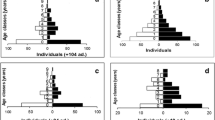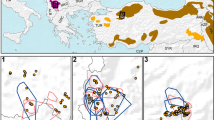Abstract
The combination of intensive persecution, habitat loss and prey deficiency led to the extinction of Eurasian lynx (Lynx lynx) in the Dinaric Mountains at the beginning of the 20th century. In 1973, the population was re-established by reintroducing animals from the Slovakian Carpathian Mountains into Slovenia, from where the animals spread into Croatia and Bosnia and Herzegovina. Since the end of the 20th century the reintroduced population has been decreasing, leading us to investigate the principal causes of mortality. Understanding the causes of the declining lynx population in Croatia and elsewhere is important not only in its own right but also because few studies have examined how large carnivore populations have fared under different management regimes. After reintroduction, the first dead lynx was recorded in Croatia in 1978, and from that year until 2013 a total of 232 deaths were recorded. Annual mortality during this period averaged 6.4 deaths per year, ranging from 0 to 17. The number of dead lynxes found every year in the period before the legal protection (1978–1998) was significantly higher than the number of dead animals found in the period after the legal protection (1998–2013). The vast majority of deaths were human-related (92.7%), with only 2.1% not human-related; while the cause of the remaining 5.2% of deaths was undetermined. Shooting was the most dominant cause of death (73.7%), with significantly more males being killed by shooting than females, and significantly more animals shot before the legal protection. Between 1978 and 1998, the year when the lynx became legally protected in Croatia, 10 deaths due to poaching were recorded, accounting for 5% of all deaths in that period and an average of 0.48 poaching cases per year. During 1999–2013,18 poaching deaths occurred, accounting for 60% of all deaths in that period and an average of 1.2 poaching cases per year. Our findings suggest that the synergy of human-induced mortality, concomitant reduction in genetic variation and possibly prey deficiency may be the principal factors behind the decline in the reintroduced lynx population in Croatia since the end of the 20th century.
Similar content being viewed by others
References
Andersen, R., Linnell, J.D.C, Hustad, H., Brainerd, S., 2004. Large carnivores and human communities: a guide to coexistence in the 21st century, Norw. Inst. Nat. Res. 25, 1–48.
R. Andersen, J.D.C. Linnell, J. Odden, H. Andrén, B.E. Sæther, P.F. Moa, I. Herfindal, T. Kvam, H. Brøseth, 2013, Gaupe—bestandsdynamikk, bestandsutviklingg høstingsstrategier (Lynx—population dynamics, development, and harvest). NINA Fagrapport.
Andrèn, H., Linnell, J.D.C, Liberg, O., Andersen, R., Danell, A., Karlsson, J., Odden, J., Moa, P.F., Ahlqvist, P., Kvam, T., Franzen, R., Segerstrom, P., 2006. Survival rates and causes of mortality in Eurasian lynx (Lynx lynx) in multi-use landscapes, Biol. Conserv. 131, 23–32.
Bischof, R., Swenson, J.E., Yoccoz, N.G., Mysterud, A., Gimenez, O., 2009. The magnitude and selectivity of natural and multiple anthropogenic mortality causes in hunted brown bears, J. Anim. Ecol. 78, 656–665, https://doi.org/10.1111/j.1365-2656.2009.01524.x
Breitenmoser, U., Breitenmoser-Würsten, C, Capt, S., 1998. Re-introduction and present status of lynx (Lynx lynx) in Switzerland, Hystrix 10, 17–30.
Breitenmoser, U., Breitenmoser-Würsten, C, Carbyn, L.N., Funk, S.M., 2001. Human-carnivore interactions, adopting proactive strategies for complex problems. In: Gittleman, J.L., Funk, S.M., Macdonald, D., Wayne, R.K. (Eds.), Carnivore Conservation. Cambridge University Press, Cambridge, pp. 179–195.
Breitenmoser-Würsten, Ch., Vandel, J.M., Zimmermann, F., Breitenmoser, U., 2007. Demography of lynx Lynx lynx in the Jura Mountains, Wildl. Biol. 13, 381–392.
Červeny, J., Koubek, P., Bufka, L., 2002. Eurasian Lynx (Lynx lynx) and its chance for survival in Central Europe: the case of the Czech Republic, Acta. Zool. Lit. 12, 362–366.
Čop, J., 1987. Propagation pattern of re-introduced population of lynx (Lynx lynx L) in Yugoslavia (1973 Slovenia-Kocevsko) and its impact on the ungulate community. In: Atti del convegno Reintroduzione dei predatori nele aree protette, Torino, pp. 83–91.
Frković, A., 1998. Ponovno naseljavanje i ulov risa (Lynx lynx L) u Zupaniji primorsko–goranskoj u razdoblju od 1974.-1996. godine. In: Zbornik radova Prirodoslovna istrazivanja Rijeckog podrucj. Prirodoslovni muzej Rijeka, Rijeka, pp. 493–500.
Frković, A., 2001. Ris (Lynx lynx L.) u Hrvatskoj – naseljavanje: odlov i brojnost (1974-2000). Sumarski list 11–12, 625–634.
Gomerčić, T., Gužvica, G., Duras Gomerčić, M., Frković, A., Pavlović, D., Kusak, J., Sindičić, M., Huber, Ð., 2009. Variation in teeth number, teeth and skull disorders in Eurasian lynx, Lynx lynx from Croatia, Folia Zool. 58, 57–65.
Gomerčić, T., Sindičić, M., Ðuras Gomerčić, M., Gužvica, G., Frković, A., Pavlović, D., Kusak, J., Galov, A., Huber, Ð., 2010. Cranial morphometry of the Eurasian lynx (Lynx lynx L.) from Croatia, Vet. Arhiv 80, 393–410.
Henriksen, H., Andersen, R., Hewison, A.J.M., Gaillard, J.M., Bronndal, M., Jonsson, S., Linnell, J.D.C, Odden, J., 2005. Reproductive biology of captive Eurasian lynx Lynx lynx, Eur. J. Wildl. Res. 51, 151–156.
Jędrzejewski, W., Jędrzejewska, B., Okarma, H., Schmidt, K., Bunevich, A.N., Miłkowski, L, 1996. Population dynamics (1869-1994) demography, and home ranges of the lynx in Białowieza Primeval Forest (Poland and Belarus), Ecography 19, 122–138.
Kleiven, J., Bjerke, T., Kaltenborn, B.P., 2004. Factors influencing the social acceptability of large carnivore behaviors, Biodivers. Conserv. 13, 1647–1658.
I. Kos, H. Potočnik, T. Skrbinšek, A. Skrbinsek Majič, M. Jonozovič, M. Krofel, 2005. Ris vSloveniji: Strokovna izhodišča za varstvo in upravljanje, 2. dopolnjena izdaja. Biotehniška fakulteta Oddelek za biologijo, Ljubljana.
Linnell, J.D.C, Broseth, H., Odden, J., Nilsen, E.B., 2010. Sustainably harvesting a large carnivore? development of Eurasian Lynx populations in Norway during 160 years of shifting policy, Environ. Manage. 45, 1142–1154.
López, G., López-Parra, M., Garrote, G., Fernández, L., del Rey-Wamba, T., Arenas-Rojas, R., García-Tardío, M., Ruiz, G., Zorrilla, I., Moral, M., Simón, M.A., 2014. Evaluating mortality rates and causalities in a critically endangered felid across its whole distribution range. Eur. J. Wildl. Res., https://doi.org/10.1007/s10344-013-0794-8
Millán, J., Candela, M.G., Palomares, F., Cubero, M.J., Rodríguez, A., Barral, M., Fuente, J., Almería, S., León-Vizcaíno, L, 2009. Disease threats to the endangered Iberian lynx (Lynx pardinus), Vet. J. 182, 114–124.
Meli, M.L., Simmler, P., Cattori, V., Martínez, F., Vargas, A., Palomares, F., López-Bao, J.V., Simón, M.A., López, G., León-Vizcaino, L, Hofmann- Lehmann, R., Lutz, H., 2010. Importance of canine distemper virus (CDV) infection in free-ranging Iberian lynxes (Lynx pardinus), Vet. Microbiol. 146, 132–137.
Nilsen, E.B., Broseth, H., Odden, J., Linnell, J.D.C, 2012. Quota hunting of Eurasian lynx in Norway: patterns of hunter selection, hunter efficiency and monitoring accuracy, Eur. J. Wildl. Res. 58, 325–333.
Palomares, F., Godoy, J.A., López-Bac,J.V., Rodríguez, A., Roques, S., Casas-Marce, M., Revilla, E., Delibes, M., 2012. Possible extinction vortex for a population of Iberian lynx on the verge of extirpation, Conserv. Biol. 26, 689–697.
Potočnik, H., Skrbinšek, T., Kos, I., 2009. The reintroduced Dinaric lynx population dynamics in PVA simulation, the 30 years retrospection and the future viability, Acta Biol. Slov. 52, 3–18.
Rodriguez, A., Delibes, M., 2004. Patterns and causes of non-natural mortality in the Iberian lynx during a 40-year period of range contraction, Biol. Conserv. 118, 151–161.
Ryser-Degiorgis, M.P., Robert, N., Lutz, H., Sager, H., Augsburger, M., Breitenmoser, U, Breitenmoser-Würsten, C, 2005. Causes of mortality and diseases in re-introduced populations of Eurasian lynx (Lynx lynx) in Switzerland. In: Proceedings of the 1st Workshop on Lynx Veterinary Aspects, Ministry of the Environment Spain.
Ryser-Degiorgis, M.P., 2009. Causes of mortality and diseases of Eurasian lynx (Lynx lynx). In: Vargas, A., Breitenmoser-Würsten, C, Breitenmoser, U. (Eds.), Iberian Lynx Ex Situ Conservation: An Interdisciplinary Approach. Fundación Biodiversidad, IUCN Cat Specialist Group, Madrid, pp. 275–289.
Schmidt-Posthaus, H., Breitenmoser-Würsten, C, Posthaus, H., Bacciarini, L.N., Breitenmoser, U., 2002. Causes of mortality in reintroduced Eurasian lynx in Switzerland, J. Wildl. Dis. 38, 84–92.
Sindičić, M., Sinanović, N., Majić Skrbinšek, A., Huber, Ð., Kunovac, S., Kos, I., 2010a. Legal status and management of the Dinaric lynx population. Veterinaria 58, 229–238.
Sindičić, M., Polanc, P., Gomerčić, T., Jelenčić, M., Huber, Ð., Trontelj, P., Skrbinšek, T., 2013. Genetic data confirm critical status of the reintroduced Dinaric population of Eurasian lynx, Conserv. Genet. 14, 1009–1018.
M. Sindičić, A. Štrbena, P. Oković, Ð Huber, J. Kusak, T. Gomerčić, V. Slijepčević, I. Vukušić, A. Majić Skrbinšek, Ž. Štahan, 2010, Plan upravljanja risom u Republici Hrvatskoj za razdoblje od 2010. do 2015. Ministarstvo kulture. Državni zavod za zaštitu prirode, Zagreb.
Stahl, P., Vandel, J.M., 1999. Mortalité et captures de lynx (Lynx lynx) en France (1974-1998), Mammalia 63, 49–59.
von Arx, M., Breitenmoser-Würsten, C, Zimmermann, F., Breitenmoser, U., 2004. Status and Conservation of the Eurasian lynx (Lynx lynx) in Europe in 2001. KORA Bericht, Muri.
Author information
Authors and Affiliations
Corresponding author
Rights and permissions
About this article
Cite this article
Sindičić, M., Gomerčić, T., Kusak, J. et al. Mortality in the Eurasian lynx population in Croatia over the course of 40 years. Mamm Biol 81, 290–294 (2016). https://doi.org/10.1016/j.mambio.2016.02.002
Received:
Accepted:
Published:
Issue Date:
DOI: https://doi.org/10.1016/j.mambio.2016.02.002




